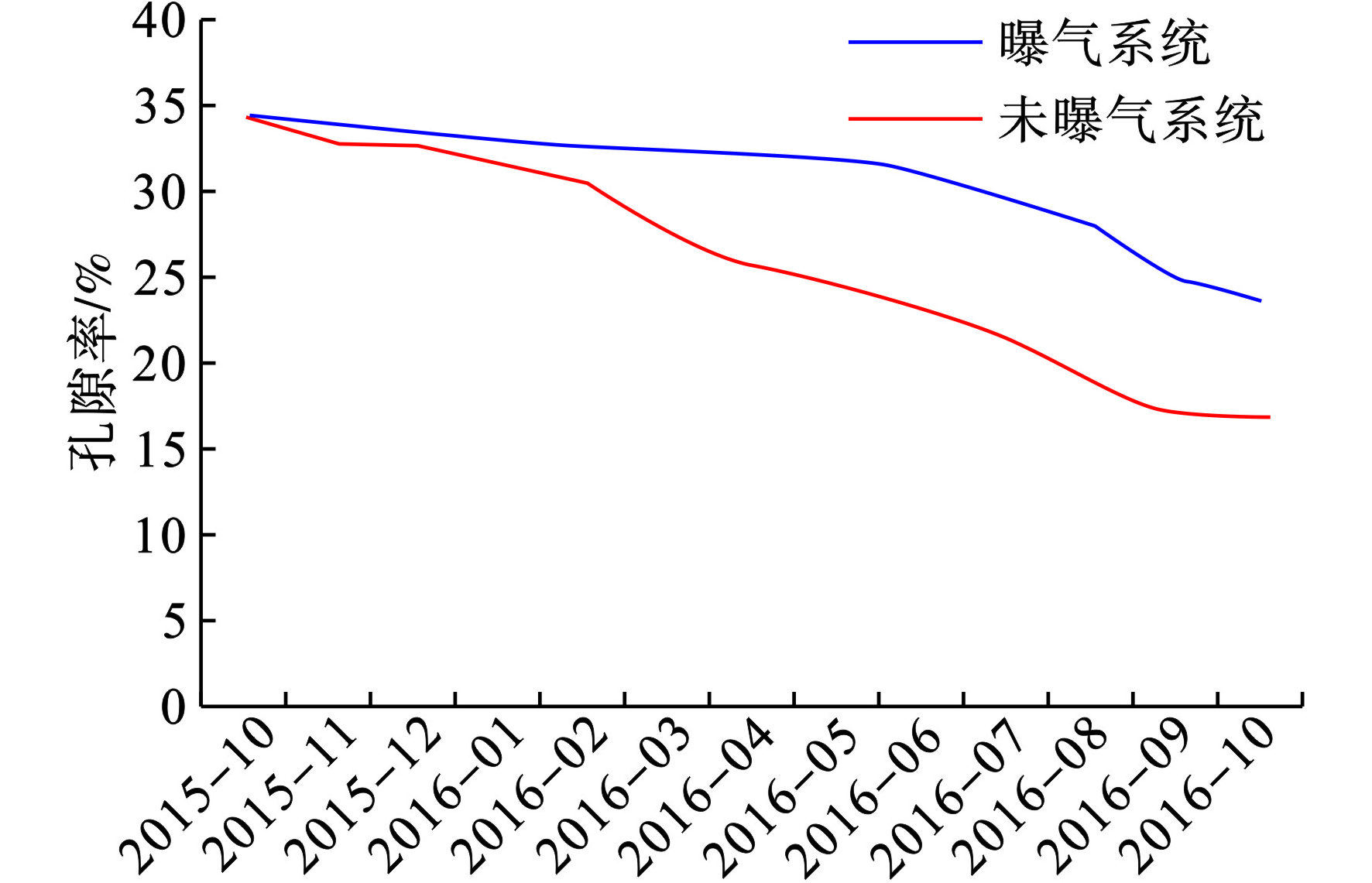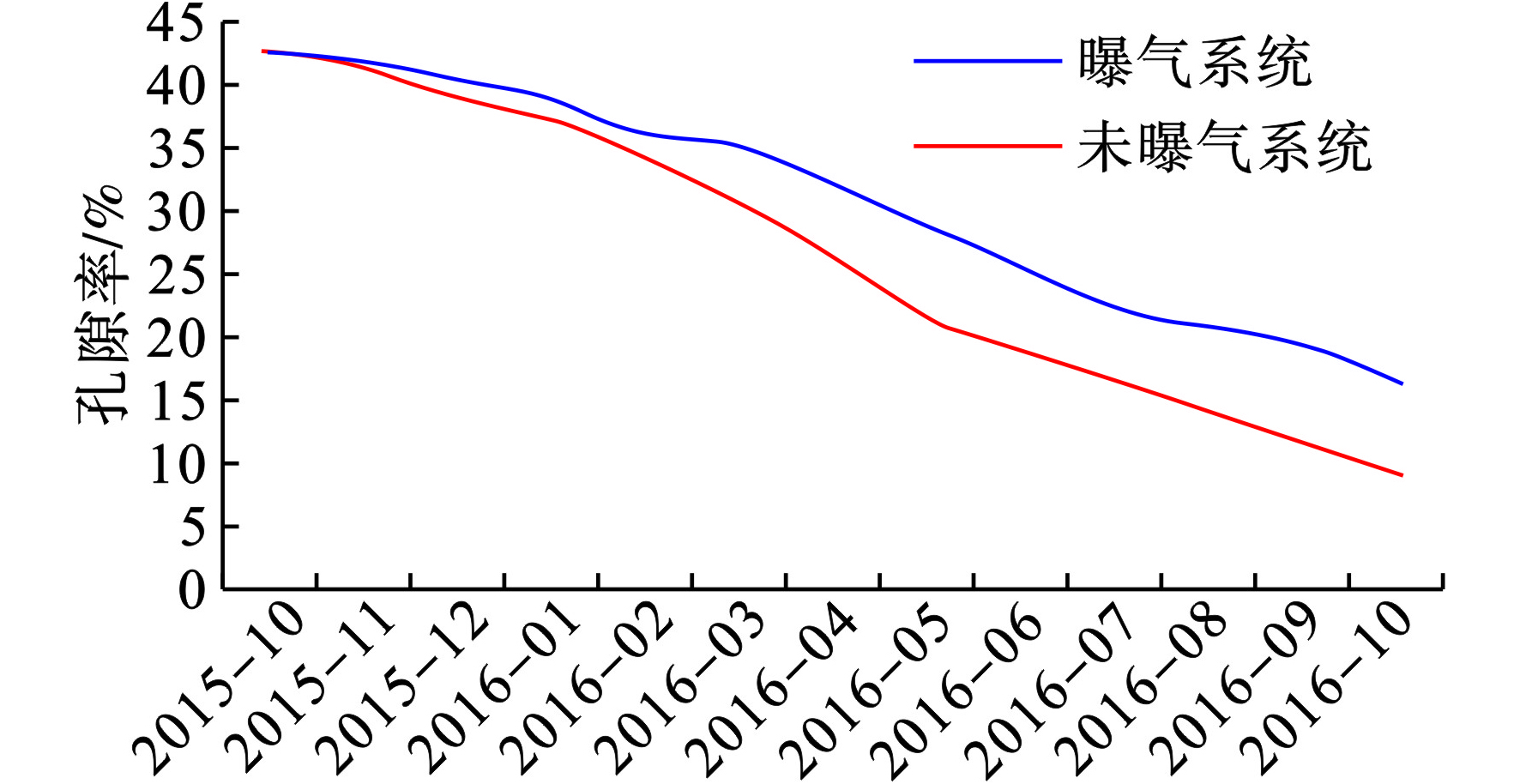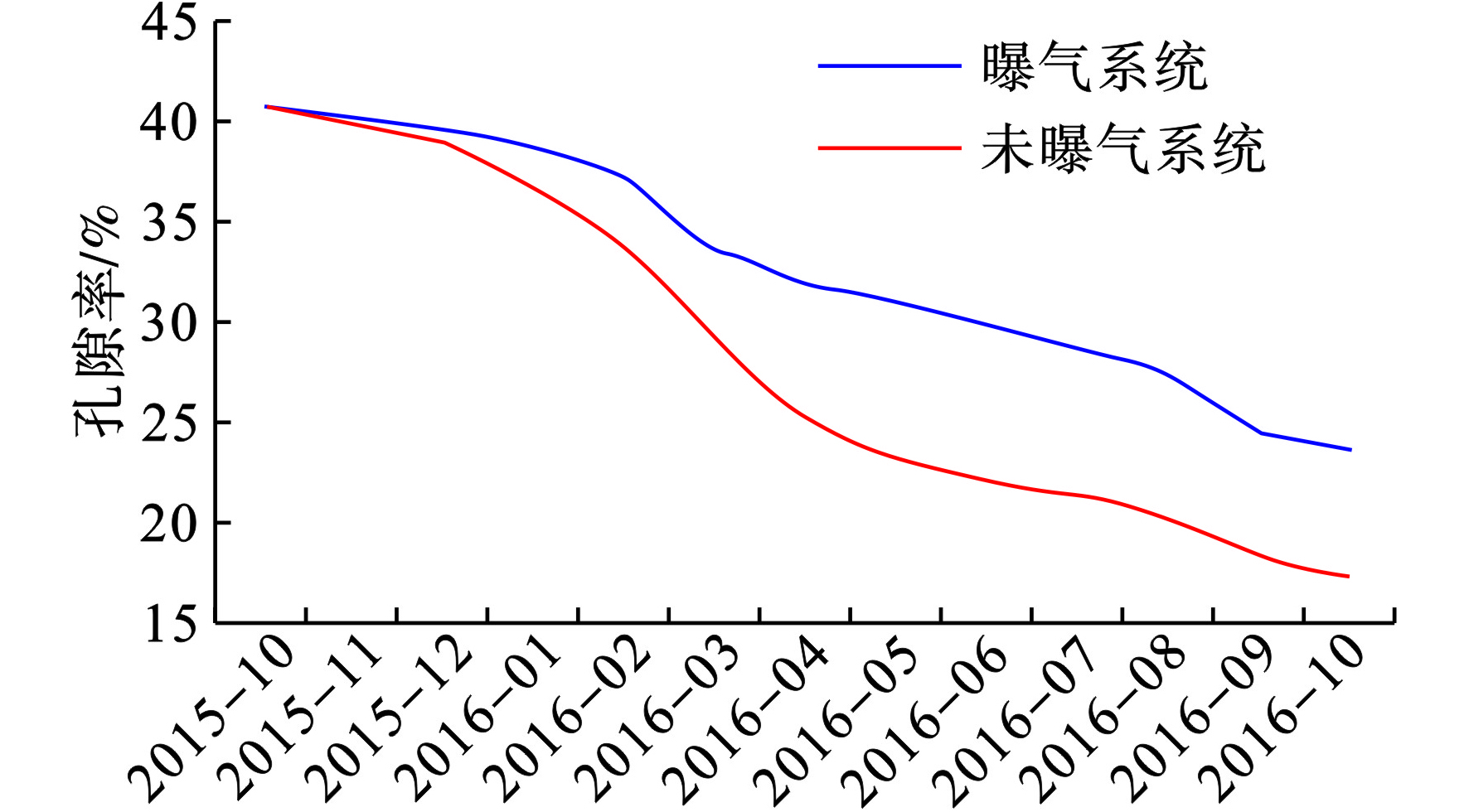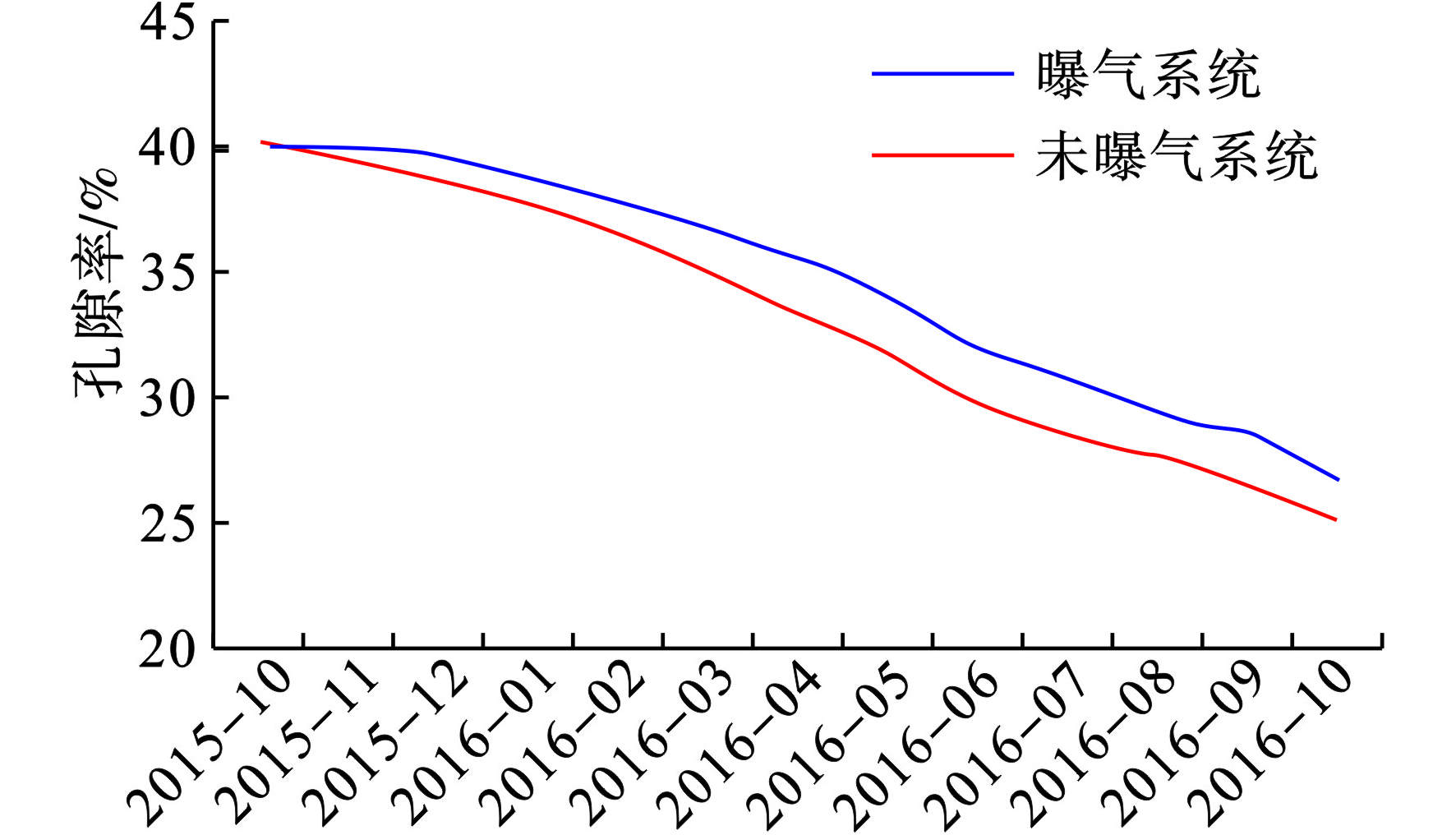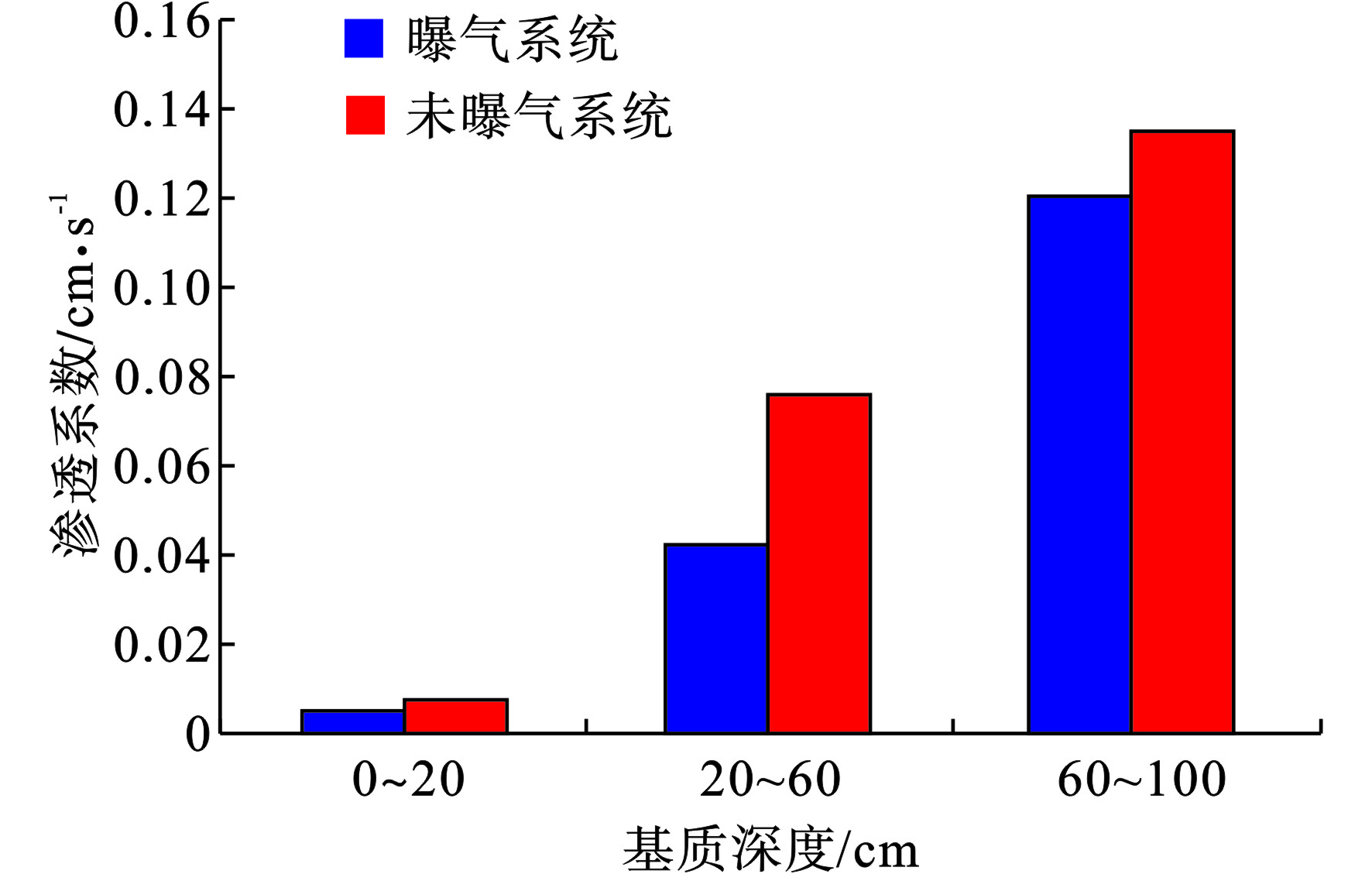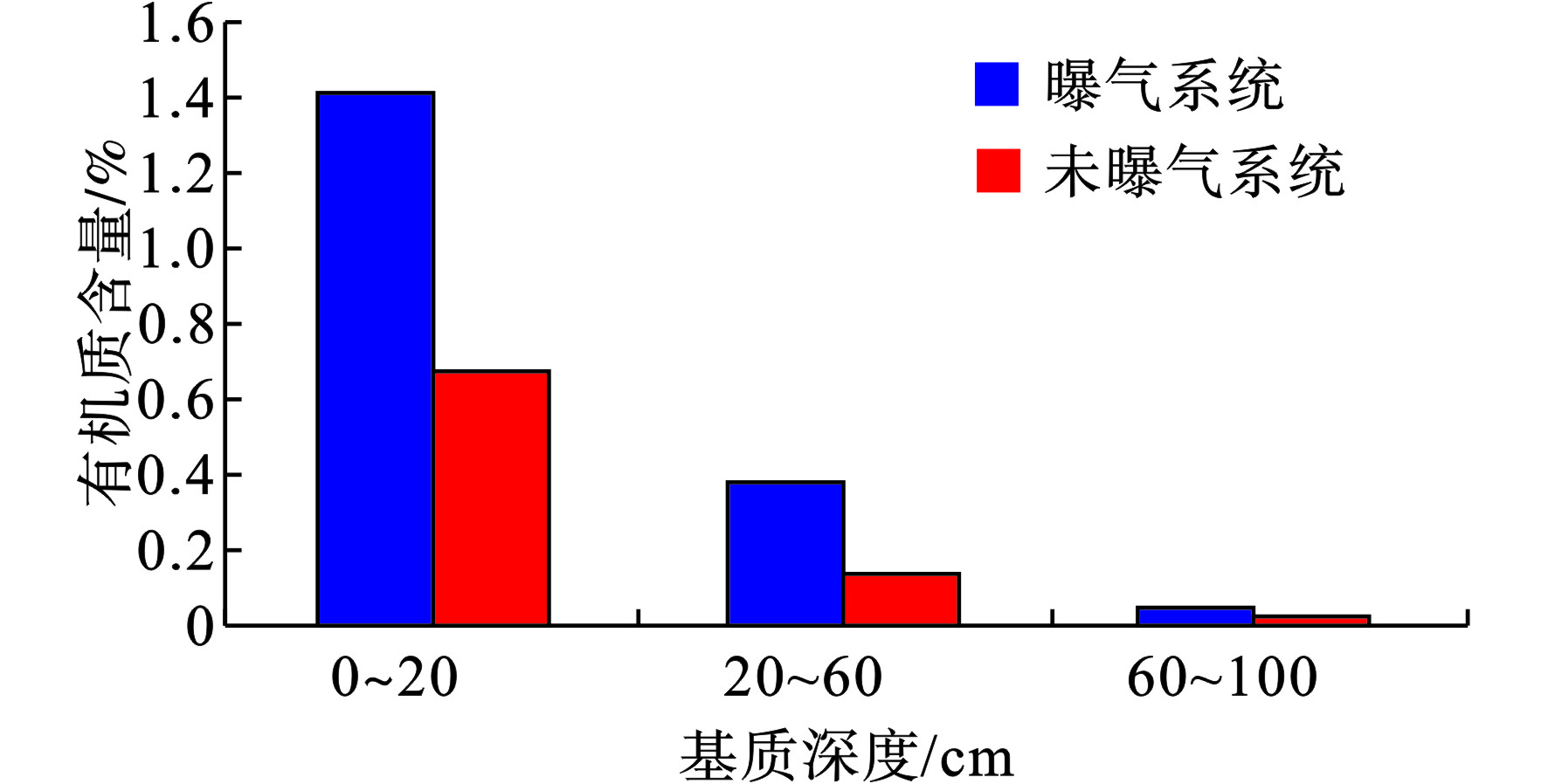-
人工湿地作为一种新的污水处理技术兴起于20世纪70年代末[1-2]。人工湿地在投入使用过程中常见的问题就是发生湿地堵塞状况,不合理的设计工艺以及运行过程中的管理不到位都将导致系统堵塞[3]。美国环境保护署(USEPA)对已经投入运行的100个人工湿地进行现状调查,结果表明已有半数的人工湿地发生了堵塞现象[4]。国内已投入运行的人工湿地中也出现了堵塞现象,例如牛山溪、白泥坑 、雁田等[5-6]人工湿地均出现不同程度的堵塞情况。堵塞将导致基质孔隙率下降,水力传导系数降低,湿地布水均匀性下降,湿地表层雍水,进而将导致湿地的处理能力下降,甚至丧失功能[7-8]。
本实验重点研究人工湿地在曝气、未曝气2种状态下堵塞现状的特征参数,包括水头损失、孔隙率、渗透系数以及有机质。并对此进行细致的检测与分析,以确定曝气、未曝气两种状态下对抑制基质堵塞的实际效果以及各个深度基质发生堵塞的过程。
-
本实验采用的人工湿地,见图1。
设计长宽高尺寸分别为6.0 m×5.0 m×1.4 m。湿地单元组成:由底向上依次为防渗膜、倒淤层、填料层、种植层。湿地植物选用驯化后的茭白,填料层分别为0.2 m种植土、0.15 m的粒径为5~10 mm碎石、0.15 m的粒径为10~30 mm碎石、0.2 m的粒径为30~80 mm碎石和0.3 m的粒径为80~120 mm卵石。茭白的种植密度为16株/m2。曝气设备选用回转式鼓风机,放置于人工湿地底部。
-
人工湿地进水来源于辉山明渠污水处理厂集水池内污水,进水水质和流量基本稳定,水质情况,见表1。
-
在人工湿地运行过程中,采用《土工试验方法标准》[9]中规定的方法,测量湿地每层的水头损失,进而测算每层基质的渗透系数。测量仪器采用微侧压板,每隔 10 d 测量1次,直至湿地出现於堵。
-
孔隙率指填料内部孔隙体积占其总体积的百分率。孔隙率的计算采用人工湿地先用水饱和后放空时的水量来计算(有效孔隙体积通过滤料饱和和放空时的水量体积进行测定)。
将实验装置通入水,水面刚好淹到基质表面,再将水放空,测得放出水的体积。孔隙率(ξ)的计算方法,见式(1)。
式(1)中,V为孔隙率排水的体积,mL;V基质为填料的堆砌的体积,mL。
-
采用常水头法测定人工湿地渗透系数,计算公式见式(2)。
式(2)中,K为渗透系数,cm/s;Q为t时间内,通过人工湿地柱的渗出水量,cm3;A为水流通过人工湿地柱断面的面积,cm2;T为渗透时间,s;L为人工湿地中基质层厚度,cm;Δh为人工湿地柱中进水与出水的水头差,cm。
-
有机质的测定,见式(3)。
式(3)中,V0为空白试验消耗的FeSO4体积,mL; V为滴定样品时消耗的FeSO4体积,mL;C为FeSO4标准溶液的摩尔浓度;0.003为碳的毫克摩尔,g;1.724为由有机碳换算成有机质的经验系数;1.08为氧化校正系数;W为风干样品重,g。
-
系统水头损失的大小直接反映湿地的堵塞情况,水损越大堵塞越严重,曝气和未曝气2种状态下不同位置深度水头损失变化情况,见表2~3。
表2和3可知,曝气系统和未曝气系统的水头损失从表层到底层均逐渐减小,曝气人工湿地系统的水头损失明显低于未曝气系统,说明曝气能够对人工湿地堵塞现象的发生起到一定的延缓作用,与祁建民等[10]研究的结果相似,人工湿地系统的堵塞位置主要发生在0~40 cm区域,其堵塞程度在水平和垂直方向上从进水端到出水口沿程递减;其中水头损失最大值达到3.5 cm·H2O。
-
孔隙率通常是指有效孔隙率,孔隙率与多孔介质固体颗粒的形状、结构和排列有关。人工湿地发生堵塞其根本原理就是湿地中基质颗粒间有效孔隙率的降低过程[11]。人工湿地系统单元的总有效孔隙率变化,见图2。
图2可知,曝气系统和未曝气系统的有效孔隙率在运行过程中均有一定程度的降低,但其降幅有明显的差异,未曝气系统降幅明显高于曝气系统。堵塞前两种状态下系统的总有效孔隙率均为34.4%,经过1年的运行,系统出现不同程度的堵塞,未曝气系统堵塞后有效孔隙率下降至16.8%;曝气系统堵塞后有效孔隙率下降至23.8%。实验结果表明,采用曝气方式可以有效降低人工湿地系统有效孔隙率的减小量,即减缓人工湿地堵塞的进程。这是因为曝气方式增加了进入系统的溶解氧含量,促进微生物的增长,大大降低有机物质在填料间的积累,进而减缓湿地堵塞进程。
通过定期对人工湿地系统填料各层有效孔隙率的测定,可以得出系统各层填料有效孔隙率变化关系,见图3~5。
图3可知,曝气和未曝气系统在0~20 cm区域的有效孔隙率随着系统运行时间的延长会呈现出不断下降的趋势,但降幅并不相同。未曝气系统上层有效孔隙率下降至8.8%,曝气系统上层有效孔隙率下降至16.3%。未曝气系统由于缺乏溶解氧,对有机物质的降解有限,进而导致大量有机悬浮物被截留下来吸附在基质表面,同时还有一定量的无机悬浮物被截留在基质空隙中,这些都导致系统有效孔隙率大幅度下降。对于曝气系统,由于系统内有足够的溶解氧,因此对有机物质的降解不受限制,大多数有机物质被好氧微生物降解,溶解氧充足会在基质内部形成较多的生物膜和胞外聚合物等物质,也会堵塞基质,另外基质空隙内存在一定量的无机悬浮物也会减小孔隙率。
图4和5可知,曝气和未曝气系统在20~60 cm区域的有效孔隙率随着系统运行时间的延长会呈现出不断下降的趋势,但降幅并不相同。与上层基质一样,未曝气系统有效孔隙率的降幅要大一些,湿地运行过程中,前半年未曝气系统呈连续下降的趋势,中后期以后降幅开始呈平缓下降。曝气和未曝气系统在60~100 cm区域的有效孔隙率随着系统运行时间的延长会呈现出不断下降的趋势,但降幅略有差异。
曝气系统和未曝气系统基质内部从表层至底层的各层有效孔隙率减少量是逐渐减少的,基质各层均有不同程度的堵塞,且沿基质表面向下堵塞程度逐渐降低。未曝气系统各层的有效孔隙率降低量都比曝气系统高,但在系统底层的有效孔隙率降低量差距较小,分析认为可能是上层基质粒径较小,进水有机悬浮物和无机悬浮物容易造成基质上层的堵塞,随着运行时间的延续,堵塞层逐渐向基质下部延伸。
-
人工湿地系统总渗透系数随时间变化趋势,见图6。
曝气系统和未曝气系统的渗透系数在运行过程中均有一定程度的降低,但是其降幅有明显的差异,且未曝气系统降幅明显高于曝气系统;未曝气系统渗透系数变化趋势较大,但下降规律基本一致,在试验中后期下降明显,区别在于未曝气系统下降较快。这主要是由于未曝气系统对污染物降解缓慢,最终导致杂质颗粒的积累;对于曝气系统,由于溶解氧供给充足,进入系统的大部分有机物和有机悬浮物被降解,截留在基质空隙中的大部分为无机悬浮物和生物膜,因此渗透系数下降较为缓慢。
人工湿地系统不同深度层渗透系数的变化,见图7。
同一系统不同深度层的渗透系数上层低于下层,且有明显降幅,曝气系统降幅小于未曝气系统降幅。另外,曝气系统上层基质的渗透系数变化也较大,这是因为曝气系统上层基质生物量较多,生成的生物膜会引起基质的堵塞,中下层渗透系数也有下降,相比上层较少。
-
实验结束后,在填料各层取样,测定填料中有机质的含量,以填料中有机质的含量来反映填料中有机悬浮物和微生物膜的含量。人工湿地系统各层有机质含量分布关系,见图8。
图8可知,同一系统内各层有机质含量也不尽相同,两个系统中的有机质含量都是随着基质深度的增加而逐渐降低。未曝气系统有机质含量明显低于曝气系统,其中未曝气系统上层基质有机质含量百分比约为0.6%,曝气系统上层基质中有机质含量高于1.4%。基质上层有机质含量高于中低层基质,与鄢璐等[12]的研究结果相近。其原因是,进水水质中的大部分溶解氧在上层基质中就被微生物消耗,因此上层基质中微生物的代谢活动最强,产生的生物膜也最多。
-
(1)曝气状态下,人工湿地系统的水头损失明显低于未曝气系统,说明曝气能够对人工湿地的堵塞现象起到一定的延缓作用,且人工湿地系统的堵塞位置主要发生在0~40 cm区域。
(2)曝气系统和未曝气系统的有效孔隙率在运行过程中均有一定程度的降低,未曝气系统有效孔隙率的降幅程度明显高于曝气系统。在1年的运行过程中,最大孔隙率降幅发生在基质上层(0~20 cm),基质中层(20~60 cm)和基质下层(60~100 cm)孔隙率的衰减明显减缓。同一系统中,基质上层孔隙率的降幅程度最高,基质中层次之,基质下层降幅程度最低。
(3)人工湿地系统的总渗透系数随时间变化均有一定程度的降低,未曝气系统的渗透系数明显低于曝气系统。未曝气系统渗透系数的变化趋势较大,但下降规律基本一致。同一系统不同深度层的渗透系数上层低于下层,且有明显降幅。
(4)堵塞湿地中有机质积累严重,曝气系统下有机质的含量明显高于未曝气系统。其中,未曝气系统上层基质有机质含量百分比约为0.6%,曝气系统上层基质中有机质含量高于1.4%。有机质的积累主要发生在基质上层,随着基质深度的增加,有机质的含量逐渐降低。
曝气对潜流人工湿地堵塞过程的控制效果研究
Research on control effect of aeration on blocking process of subsurface flow constructed wetland
-
摘要: 为了解决人工湿地在运行过程中发生的堵塞状况,在曝气和未曝气两种状态下,对人工湿地系统各个深度基质堵塞过程情况进行了研究。结果表明:在曝气状态下,人工湿地系统堵塞情况优于未曝气状态下,堵塞过程中的水头损失低于未曝气状态,孔隙率和渗透系数的下降趋势均低于未曝气状态,有机质的含量高于未曝气状态。人工湿地的堵塞程度表现为上层基质(0~20 cm)高于中层基质(20~60 cm)高于低层基质(60~100 cm)。Abstract: In order to solve the blockage of the constructed wetland during operation, under the condition of aeration and non-aeration, the blockage process of each depth matrix of the constructedted wetland system is studied. The results show that the blockage of the constructed wetland system with aeration is better than that without aeration. The head loss and the decreasing trend of the porosity as well as the permeability coefficient are all lower than that under non-aeration condition. While the content of organic matter with aeration is higher. The blockage degree of the constructed wetland indicates that the upper substrate (0~20 cm) is higher than the middle substrate (20~60 cm) and the lower substrate (60~100 cm).
-
Key words:
- constructed wetlands /
- aeration /
- blocking /
- head loss /
- porosity
-

-
表 1 人工湿地进水水质
mg·L−1 项目 COD NH3-N TP TN 进水 47.57 ~113.02 5.78 ~11.24 1.62 ~3.46 13.8~49.2 表 2 未曝气系统不同位置深度水头损失变化情况
水平深度/cm 垂直深度/cm 20 40 60 80 20 3.5 cm·H2O 3.5 cm·H2O 3.2 cm·H2O 3.2 cm·H2O 40 1.4 cm·H2O 1.2 cm·H2O 1.1 cm·H2O 1.1 cm·H2O 60 0.6 cm·H2O 0.6 cm·H2O 0.6 cm·H2O 0.6 cm·H2O 80 0.3 cm·H2O 0.2 cm·H2O 0.1 cm·H2O 0.1 cm·H2O 表 3 曝气系统不同位置深度水头损失变化情况
水平深度/cm 垂直深度/cm 20 40 60 80 20 3.2 cm·H2O 2.9 cm·H2O 2.8 cm·H2O 2.7 cm·H2O 40 1.0 cm·H2O 0.9 cm·H2O 0.7 cm·H2O 0.7 cm·H2O 60 0. 4 cm·H2O 0.3 cm·H2O 0.3 cm·H2O 0.3 cm·H2O 80 0.1 cm·H2O 0.1 cm·H2O 0.1 cm·H2O 0.1 cm·H2O -
[1] 杜娟娟, 李荣峰, 李扬, 等. 人工湿地污水处理技术研究进展[J]. 山西水利科技, 2015(2): 59 − 62. doi: 10.3969/j.issn.1006-8139.2015.02.020 [2] STECHER M C, WEAVER R W, et al. Effects of umbrella palms and wastewater depth on wastewater treatment in a subsurface flow constructed wetland[J]. Environmental Technology, 2003, 24(4): 471 − 478. doi: 10.1080/09593330309385582 [3] 张亮, 曹营渠, 易畅, 等. 人工湿地堵塞的研究进展[J]. 四川环境, 2017, 36(S1): 174 − 178. [4] USEPA. Subsurface flow constructed wetlands for wastewater treatment[M] . Washington DC. USEPA 832-R-93-008, 1993. [5] 姜波. 牛山溪溢流雨污水处理工程优化研究[D]. 武汉: 华中科技大学, 2019. [6] 陈韫真, 叶纪良. 深圳白泥坑、雁田人工湿地污水处理场[J]. 电力环境保护, 1996, 12(1): 47 − 51. [7] 林莉莉, 鲁汭, 肖恩荣, 等. 人工湿地生物堵塞研究进展[J]. 环境科学与技术, 2019, 42(6): 207 − 214. [8] ZHAO L F, ZHU W, et al. Clogging processes caused by biofilm growth and organic particle accumulation in lab-scale vertical flow constructed wetlands[J]. Journal of Environmental Sciences, 2009, 21(6): 750 − 757. doi: 10.1016/S1001-0742(08)62336-0 [9] 中华人民共和国水利部, 中华人民共和国建设部. 土工试验方法标准: GB/T 50123-1999[S]. 北京: 中国标准出版社, 1999 [10] 祁建民, 黄治军, 傅高健, 等. 人工曝气不同气水比下人工湿地堵塞现状[J]. 环境科技, 2019, 32(5): 6 − 11. doi: 10.3969/j.issn.1674-4829.2019.05.002 [11] 赵慧敏, 赵剑强. 潜流人工湿地基质堵塞的研究进展[J]. 安全与环境学报, 2015, 15(1): 235 − 239. [12] 鄢璐, 王世和, 黄娟, 等. 潜流型人工湿地基质堵塞特性试验研究[J]. 环境科学, 2008(3): 627 − 631. doi: 10.3321/j.issn:0250-3301.2008.03.014 -




 下载:
下载:
